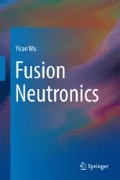Abstract
Devoted to describing neutron movement in media and the corresponding laws, neutron transport theory is the research basis for transmutation and activation, radiation damage to materials, radiation dose, and biological safety, among other topics. There are two methods for neutron transport calculation: the Monte Carlo method (also called the probabilistic method or the stochastic method) and the deterministic method. This chapter introduces the basic principles of neutron interactions with matter, neutron transport theory, simulation methods and codes for fusion neutron transport calculations.
Access this chapter
Tax calculation will be finalised at checkout
Purchases are for personal use only
References
Lamarsh JR (1966) Introduction to nuclear reactor theory. Addison-Wesley Publication Company, Massachusetts
Lewis EE, Miller WF Jr (1993) Computational methods of neutron transport. American Nuclear Society, La Grange Park, Illinois
Wilson RPH, Feder R, Fischer U et al (2008) State-of-art 3-D radiation transport methods for fusion energy system. Fusion Eng Des 83:824–833
Wu YC, Song J, Zheng HQ et al (2015) CAD-Based Monte Carlo Program for integrated simulation of nuclear system SuperMC. Ann Nucl Energy 82:161–168
Song J, Sun GY, Chen ZP et al (2015) Study on Monte Carlo K-effective calculation method. Nuclear Sci Eng 35(2): 241–245 (in Chinese)
Haghighat A, Wagner JC (2003) Monte Carlo variance reduction with deterministic importance functions. Prog Nuclear Energy 42(1):25–53
Zhao JB, Li XM, Wu B et al (2016) An automatic adaptive mesh generation method for weight window in Monte Carlo particle transport. Ann Nuclear Energy 91:105–110
Wagner JC, Blakeman ED, Peplow DE (2007) Forward-weighted CADIS method for global variance reduction. Trans Am Nuclear Soc 97:630–633
Davis A, Turner A (2011) Comparison of global variance reduction techniques for Monte Carlo radiation transport simulations of ITER. Fusion Eng Des 86(9–11):2698–2700
Zhang S, Yu SP, He P (2016) Verification of SuperMC with ITER C-Lite neutronic model. Fusion Eng Des 113:126–130
Chen ZP, Song J, Wu B et al (2015) Optimal spatial subdivision method for improving geometry navigation performance in Monte Carlo particle transport simulation. Ann Nuclear Energy 76:479–484
Askew JR (1972) A characteristics formulation of the neutron transport equation in complicated geometries. Report AEEW-M 1108. United Kingdom Atomic Energy Establishment, Winfrith, England
Bell GI, Glasstone S (1970) Nuclear reactor theory. Van Nostrand Reihold Company, New York
Wu YC, Xie ZS, Fischer U (1999) A discrete ordinates nodal method for one-dimensional neutron transport calculation in curvilinear geometries. Nuclear Sci Eng 133:350–357
Azmy Y, Sartori E (2010) Nuclear computational science: a century in review. Springer, Berlin
Wu YC, Team FDS (2009) CAD-based interface programs for fusion neutron transport simulation. Fusion Eng Des 84(7–11):1987–1992
X-5 Monte Carlo Team (2003) MCNP-A general Monte Carlo N-particle Transport Code, Version 5. LA-UR-03-1987, Los Alamos National Laboratory
Brun E, Damian F, Diop CM et al (2015) TRIPOLI-4, CEA, EDF and AREVA reference Monte Carlo code. Ann Nucl Energy 82:151–160
Leppanen J, Pusa M, Vitanen T (2015) The serpent Monte Carlo code: status, development and applications in 2013. Ann Nucl Energy 82:142–150
Tabbakh F (2016) Particles transportation and nuclear heating in a tokamak by MCNPX and GEANT4. J Nucl Energy 35:401–406
Ferrari A, Sala PR, Fasso A et al (2011) Fluka: a multi-particle transport code. CERN-2005-010, Geneva
Niita K, Sato T, Iwase H et al (2006) PHITS-A particle and heavy ion transport code system. Rad Meas 41(9–10):1080–1090
Oak Ridge National Laboratory (1998) DOORS3.2 one, two- and three dimensional discrete ordinates neutron/photon transport code system. CCC-650, Oak Ridge, Tennessee
Youssef M, Feder R, Batistoni P et al (2013) Benchmarking of the 3-D CAD-based discrete ordinates code “ATTILA” for dose rate calculations against experiment and Monte Carlo calculations. Fusion Eng Des 88:3033–3040
Author information
Authors and Affiliations
Corresponding author
Rights and permissions
Copyright information
© 2017 Springer Nature Singapore Pte Ltd.
About this chapter
Cite this chapter
Wu, Y. (2017). Neutron Transport Theory and Simulation. In: Fusion Neutronics. Springer, Singapore. https://doi.org/10.1007/978-981-10-5469-3_2
Download citation
DOI: https://doi.org/10.1007/978-981-10-5469-3_2
Published:
Publisher Name: Springer, Singapore
Print ISBN: 978-981-10-5468-6
Online ISBN: 978-981-10-5469-3
eBook Packages: Physics and AstronomyPhysics and Astronomy (R0)

